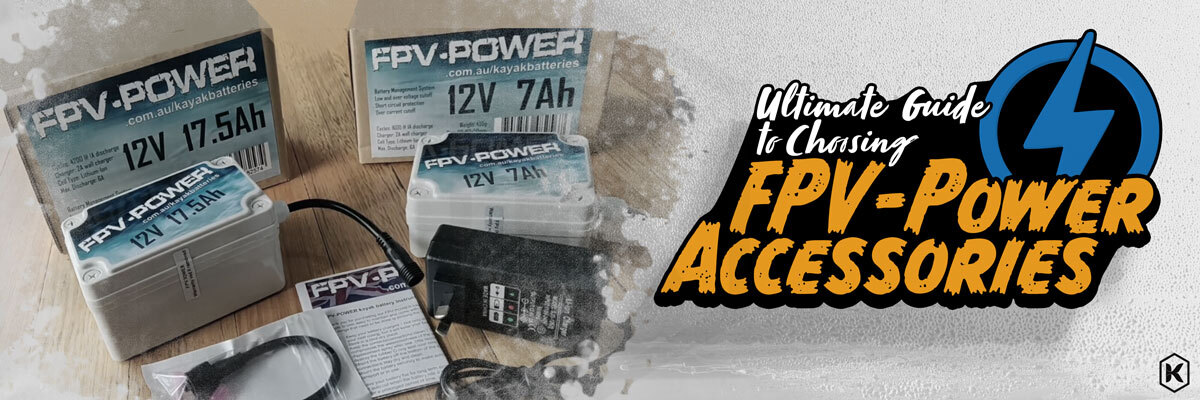Ultimate Guide to Choosing FPV-Power Accessories

In today’s world of powered devices and mobile electronics, you don’t need to leave it all behind when you head out on your kayak. There are many applications for powered systems on your kayak, and the one you choose can be determined by what you need to run.
If you are a casual kayaker, you may only need enough power to recharge your camera and phone. The system you choose needs to be waterproof and charge you enough to get through the day. When running a fishing kayak, you may need more power than most users, especially if you’re running an electric outboard or a lighting system. Before planning your lighting setup, you may want to think about what you’ll use and how many access points you’ll require. \
What makes FPV-Power an excellent choice for kayaks
FPV-Power started making batteries for the remote control (RC) industry, including vehicles, planes, and drones. Working in this industry helped them develop lightweight batteries, which are vital for drones and other RC units. FPV-Power was one of the first companies to supply lithium-ion (Li-ion) batteries for the drone industry. After this success, they started developing a waterproof solution for the marine industry, as there was a need in the small marine craft industry for a high-quality, low voltage battery system.
The research and development (R&D) into the kayaking power industry lead the team at FPV-Power to create the 7Ah and the 17.5Ah Li-ion batteries. One of the main problems that kayakers face with battery systems is weighing. During their R&D, FPV-Power found that most kayakers were using lead-acid batteries, and these will weigh around 2.5kg for 7Ah, and the Li-ion is under 0.5kg for 7Ah. The Li-ion batteries from FPV-Power have an onboard battery management system that will turn the battery off when it reaches an optimal discharge (1Ah). This type of functionality was missing in most systems and was challenging to manage with lead-acid batteries, especially in limited space environments. A Li-ion battery has a longer life span than a comparable lead-acid battery. Most lead-acid batteries will last for around 300-350 cycles, but only at a 50% discharge capacity, whereas the 17.5Ah battery can be cycled over 4000 times down to a discharge capacity of 90%.
All of this means that your Li-ion battery will last around ten times longer than a standard lead-acid battery. The Li-ion is lighter and has a smaller footprint, which is ideal when using it where space is a premium. A Li-ion battery does come with a higher price tag attached, but the overall savings are well worth it, as you won't need to replace your batteries as often.
Battery management system for a kayak
The range of Li-ion batteries from FPD-Power has been specifically designed to provide reliable power to all devices you’ll find on a kayak. You can use the smaller batteries for low power consumption devices such as fish finders and other small devices. When you need power for your outboard motor, you can use their larger batteries as these have enough for a few hours of use, depending on your particular model.
When deciding on the right setup for your particular kayak, you can examine what items you’ll include. You’ll need to total up all the electronics and decide which size battery (or batteries) will be ideal. For example, if you're running an outboard motor and a fish finder unit, you may prefer to install a small battery for the finder and a larger one for the outboard, or you may prefer to use one battery to power both devices.
In planning your system, you may prefer to organise all your electronics and determine the best space for the batteries. All the Li-ion batteries from FPV-Power are housed inside an IP67 rated case and come with a suitable battery plug. While these batteries are primarily designed for kayaks and other watercraft, they can be removed from your boat and used in various settings (camping, etc.).
Choosing the best battery packs for your kayak
With any FPV-Power battery, you'll find it includes a built-in battery management system. This system offers short circuit protection and a discharging safety cutoff that protects your battery when something is wrong. How much batteries weigh is usually of concern to kayakers. The FPV-power lithium batteries are well known for offering excellent power while being lightweight.
FPV-Power lithium batteries can power a trolling motor and any other electronic device. When choosing your battery and charger combo, check that there is enough power to run all your onboard devices and an additional 10% above your needs. Adding in this extra amount will give you a buffer amount of charge, and make sure you have a little extra if you need it. Your kayak battery will auto cut off when there is a short on any of your devices. If you find that your battery is not lasting as long as it should, there may be a potential problem with your devices, and they may need to be replaced or repaired.
The kayak lithium battery from FPV-Power is housed inside a waterproof hard case, so you don't need to keep them installed inside a dry environment. With the battery management system built-in, you can relax knowing that your batteries will cut off at the optimum time. All the FPV-Power lithium batteries will come complete with a wall charger, and this can be installed in your home to provide fast charging.
FAQ for FPV-Power and kayaks
What kind of battery is best for a kayak?
The best battery for a kayak is a lithium-ion battery. FPV-Power battery packs are designed specifically for kayaks, and their battery packs come complete with a waterproof hard case. FPV-Power has an inbuilt battery management system for charging and discharging safety.
How much power do I need on a kayak?
The amount of power you need on a kayak depends on what you plan on running. For example, if you have a fish finder, you may need the FPV-Power 7Ah battery. If you're running a trolling motor, you may need a larger battery as these typically draw more power.
How long will an electric motor last on a battery?
Many factors will go into how long your electric motor will last. The main factors are how large is your battery, how much power your motor requires, and how heavy is your kayak. With an FPV-Power 50Ah battery, you can expect 2-3 hours of use for motors under 50lb of thrust.
Do I need lighting on my kayak?
Lighting systems are necessary for kayaking at night or in any low light situation. If you plan to be on your kayak before sunrise or after sunset, then having a suitable light setup is vital. As most kayak lighting uses LED lights, running your lights using an FPV-Power 17.5Ah battery may be possible.
Are batteries safe to use on a kayak?
Any battery used on a kayak should be housed inside a waterproof case. All FPV-Power batteries are designed for use on the water and come inside a suitable case. If you're using a lead-acid battery for your power, you may need to use a marine box or some other waterproof case.
How much are kayak batteries?
Kayak batteries from FPV-Power will range in price based on how much charge they can deliver. An FPV-Power 7Ah set is a good starting point when introducing power to your kayak. You can add extra batteries or replace your 7Ah unit with a larger battery as you increase your onboard devices.
Where to buy the best kayak FPV-Power accessories
At Kayaks2Fish, we have an excellent selection of FPV-Power batteries and accessories to make powering your kayak easy. The most common use for a battery system on a kayak is to power a fish finder, lighting systems, and trolling motors. For smaller devices such as fish finders and charging phones or cameras, we'd recommend the FPV-Power 7Ah and 17.5Ah batteries. A 50Ah will be suitable for smaller motors when using a trolling motor and provide enough power for a few hours of use.
If you need help choosing the right batteries for your kayak, you can phone our local team, and we'll offer our expert advice.










